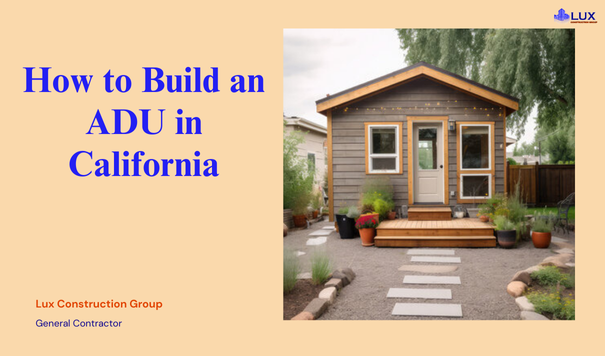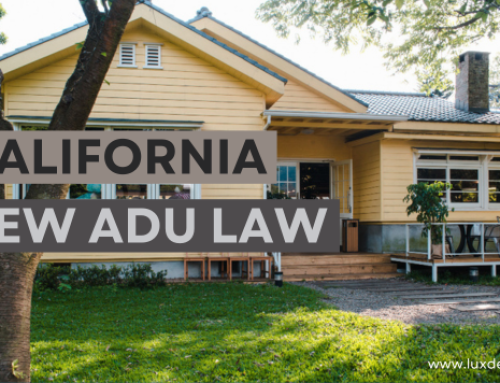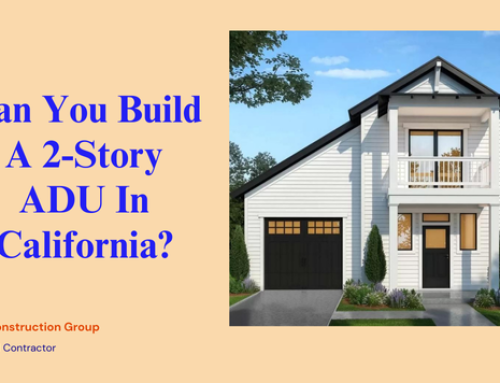Accessory dwelling units, commonly known as ADUs, are becoming increasingly popular, and it’s easy to see why. These versatile living spaces offer numerous benefits, but building one can seem daunting. That’s where our comprehensive ADU Construction Checklist comes in!
We understand that constructing an ADU involves juggling numerous elements, from planning to execution. That’s why we’ve crafted this checklist to guide you through each step of the process.
If you’re feeling a bit overwhelmed about starting your ADU project, don’t worry. Our checklist is designed specifically to help ease your concerns and provide a clear path forward.
Let’s dive into the details of ADU construction together!
Contents
- What is an ADU?
- Why Many Families in California Are Turning to ADUS as Housing Options?
- ADU Construction Checklist – How to Build an ADU
- Think About Reasons For Building
- Hire A General Contractor
- Consider The Type of ADU
- Research The ADU Ordinance in Your City
- Calculate the Cost of Your ADU
- Rough Construction
- Utilities
- Fixtures & Finishes
- Sitework & Misc.
- Bathroom
- Kitchen
- Floor Plans
- Interior and Exterior
- City Revisions & Permit Review
- Start Building
- Do You Want An ADU? Contact LUX Construction Group!
- FAQs – Frequently Asked Questions
- What will be the cost of constructing an ADU?
- How long does it take to construct an Accessory Dwelling Unit?
- What is the cost of an ADU permit?
- How long does it take to acquire an ADU permit?
What is an ADU?
When we talk about Accessory Dwelling Units or ADUs, we’re referring to compact living spaces that are often constructed on the same property as a single-family house. These units are smaller in size compared to secondary units, which are generally larger and might be separate from the main house.
On the other hand, ADUs can be either connected to the main home or stand-alone, but they are always smaller than secondary units.
ADUs come in various forms, some of the most popular being garage conversions, basement apartments, and what are affectionately known as granny flats. These units are also known by other names, such as:
- Attic apartment
- Backyard cottage
- Backyard House
- Carriage house
- Garden Cottage
- Mother-in-law suite
- Mother-in-law unit
- Secondary dwelling unit
- Tiny House
The following features always qualify a secondary residence as an ADU:
- They have independent water and utility hookups.
- They function as complete living spaces, including amenities like kitchens, bedrooms, bathrooms, and living rooms.
- They are either built on their own foundation or share a foundation with the primary residence.
Note: ADUs are similar to apartments but without the presence of a full apartment building. Notably, while tiny houses may resemble ADUs, they must meet specific criteria, including having utility hookups and a permanent foundation. Mobile homes or trailers do not qualify as ADUs as they are not permanent residences.
Why Many Families in California Are Turning to ADUS as Housing Options?
When your loved one requires accommodation, what steps do you take? You offer them a place to relax. And when they seek a permanent residence, you go to great lengths to provide them with a home.
That’s why numerous families in California are increasingly considering accessory dwelling units (ADUs) as a feasible and affordable housing solution to support the well-being of their loved ones.
If you’re contemplating constructing an ADU, thorough preparation is essential. Here’s the comprehensive guide to ADUs, covering all crucial considerations and key steps in the construction process.
ADU Construction Checklist – How to Build an ADU
Building an ADU (Accessory Dwelling Unit) can be expensive, but costs vary depending on size, location, and local rules. To get a clear idea of the cost, it’s wise to compare estimates from different contractors.
Remember, initial quotes from contractors are just rough estimates based on a basic plan or the general scope of your ADU project in Los Angeles.
You’ll get a more accurate cost once you have completed building plans, which are also needed for getting a building permit.
Let’s take a look at this checklist to determine what you need:
-
Think About Reasons For Building
Before you consider the expenses, materials, or permits involved in constructing an accessory dwelling unit (ADU), it is crucial to first address a fundamental question: Why do you want to build an ADU?
This query sounds simple, but it reveals numerous potential possibilities that can significantly influence your project’s final outcome.
For instance, are you constructing the ADU for:
- Providing a home for an elderly relative to age in place
- Facilitating multigenerational living arrangements
- Accommodating a returning adult child (“boomerang kid”)
- Housing a young adult fresh from college
- Supporting an elderly relative requiring additional care
- Assisting a special needs individual who needs accessible living options
Each scenario necessitates a unique design tailored to the occupants’ specific needs. For example, an ADU for an elderly individual might need to be accessible and adaptable to accommodate reduced mobility over time.
Furthermore, an ADU designed for someone requiring close medical support may benefit from easy access to the main home. In contrast, someone who needs only occasional family support might prefer a more autonomous setup. A young adult returning from college might appreciate an independent space that still feels personal. Whereas older adults or those with their own families might require an ADU that can accommodate multiple people.
Similarly, a solution for multigenerational living must consider the spatial needs of different family units. Each of these considerations shapes the design and functionality of the ADU, highlighting the importance of clarity in your initial intentions.
-
Hire A General Contractor
To initiate the construction of an Accessory Dwelling Unit (ADU), the first critical step is selecting the right contractor.
ADU contractors with the necessary expertise are essential to your project’s compliance and smooth execution, which is why hiring the right one is crucial. Engaging with a contractor not only helps manage your budget efficiently but also ensures that your project is completed within a predetermined timeline. This can greatly minimize unexpected costs and scheduling issues.
Moreover, working with a professional contractor reduces the stress and uncertainty associated with ADU construction. It is important to choose a contractor who not only fits your budget but also understands and aligns with your project needs.
Alternatively, you may consider hiring a construction company that specializes in ADUs. Such companies offer comprehensive services that streamline the entire process from design to completion while focusing on maintaining high-quality standards. These companies have a wealth of experience in overseeing every aspect of ADU development, including design, permitting, construction, and the application of finishing touches.
If you are looking for a seamless construction experience for your ADU, LUX Construction Group is available to assist you throughout the project. Remember, whether you choose an individual contractor or a full-service construction company, there are numerous options available to bring your ADU project to fruition.
-
Consider The Type of ADU
Consider the specific needs of your loved one when selecting the type of Accessory Dwelling Unit (ADU) that will be most appropriate.
For those with limited mobility, an ADU design that includes stairs, or a conversion of an attic or basement, might not be accessible and therefore unsuitable. Conversely, if your loved one has a family, converting an attic or basement could potentially lead to a cramped and uncomfortable living situation.
Additionally, if your loved one requires in-home care, it would be beneficial to choose an ADU that is closer to your main residence. This proximity makes it easier for you to reach your loved one when necessary, and likewise, it facilitates easier access for them to you.
In such circumstances, don’t forget to contact us to get ready-made plan sets, which can save you months in design time and potentially reduce costs.
-
Research The ADU Ordinance in Your City
Building an Accessory Dwelling Unit (ADU) is an exciting possibility for homeowners in many U.S. cities, including various places in California.
However, it’s crucial to recognize that ADU regulations are not uniform and can differ significantly from one city to another. What might be permissible in one area could be restricted in another.
Therefore, it’s essential to thoroughly understand the specific rules and guidelines that apply to your location. Remember, just because a friend or neighbor managed to build an ADU under Los Angeles ordinance conditions doesn’t automatically mean the same rules apply to your project. Every city has different ADU rules and regulations.
Here’s a breakdown of key aspects related to ADU zoning and regulations:
- Zoning Classification: ADUs are subject to zoning regulations dictating permissible locations for construction. These regulations typically designate specific zones where ADUs are allowed, such as R-1 (Residential) or R-2 (Multi-Family Residential).
- Size: ADUs come in various sizes depending on type, typically ranging from 300 to 1,200 sq ft on average.
- Setbacks: When building an ADU, specific space requirements must be adhered to by law. Setbacks typically range from 0 to 4 feet from the lot line for side and rear boundaries, with regulations determined by the city code for setbacks along the front and street.
- Building Height: Zoning codes typically specify the maximum height permitted for ADUs, including both the main structure and any additional stories or levels.
- Historic Districts: Properties located within landmark districts may be subject to additional regulations aimed at preserving the area’s historic character.
- Use and Occupancy: Zoning regulations may outline permissible uses for ADUs, including accommodation for family members, short-term or long-term rentals, or other designated purposes. Adhering to these use restrictions is essential to avoid legal complications.
- Permitting Process: ADU projects often require permits and approvals from local government authorities. This process involves submitting detailed plans, undergoing inspections, and paying relevant permit fees.
Interested in knowing if your project is possible? Our contractors provide insights into your ADU project’s viability, including potential costs, timelines, and return on investment. We’re here to assist you every step of the way!
-
Calculate the Cost of Your ADU
Building an Accessory Dwelling Unit (ADU) involves various costs, and estimating them can be tricky. Smaller ADUs often cost more per square foot than larger ones. For a 500-square-foot ADU, using the higher end of this range, the base price is around $120,000.
However, there are additional costs to consider:
- Utility Connections: Approximately $2,000.
- Utility Trenching: Ranges from $3,000 to $7,000.
- Solar Panels (optional): Between $12,000 and $17,000.
- Upgrading Electrical Panels: About $2,000.
Adding these to the base price, the total estimated cost for a 500-square-foot ADU in Los Angeles could be around $140,000. This gives you a starting point for budgeting, though actual costs may vary.
-
Rough Construction
When planning the construction of an Accessory Dwelling Unit (ADU), it’s important to understand the key components involved in the initial stages, often referred to as “Rough Construction.”
This phase lays the foundation for your ADU and involves several critical steps. It’s essential to ensure that all these elements are listed and included in the contractor’s bid. Typically, the contractor provides most of the materials required for this phase, but it’s always a good idea to confirm this directly with them.
Here’s a breakdown of what Rough Construction usually entails:
- Concrete Work: Laying the foundation, footings, and retaining walls.
- Framing: Building the basic structure, including walls, floors, and roof.
- Interior Wall and Stairway Framing: Constructing internal walls and staircases.
- Rough Electrical Work: Installing wiring and electrical panels.
- Rough Plumbing: Setting up pipes, drains, and plumbing fixtures.
Understanding these components of Rough Construction will help you ensure that your ADU project starts on the right foot, with all necessary elements properly accounted for in your agreement with the contractor.
-
Utilities
When constructing an accessory dwelling unit (ADU) or transforming your garage, it’s essential to consider the key utilities: sewer, water, electrical, and gas lines (if you’re not opting for an all-electric ADU). These utilities typically connect to various points around your main house, necessitating the digging of several trenches.
Your contractor will be well aware of this, and it should be reflected in their project estimate. To streamline the process, start by deciding where you want each utility to link up with your main building. With these connection points established, you can effectively plan the rest of your construction project. This approach helps in organizing the layout and ensuring a smoother construction process for your ADU.
-
Fixtures & Finishes
Construction of an accessory dwelling unit (ADU) can be an exciting venture. However, it’s crucial to pay close attention to the details in your contractor’s proposal to ensure nothing is missed. While most contractors are thorough in their bids, certain elements can sometimes be overlooked, particularly if you’re new to construction projects.
Here are a few of these items that are often missed:
- Flooring options, such as carpet or luxury vinyl tile.
- Various light fixtures.
- Door-related details, including doorknobs, trims, handles, and locksets.
- Bathroom finishes like shower glass and tiles.
- Kitchen essentials, including appliances like dishwashers, refrigerators, and microwaves, as well as fixtures like sinks.
- Exterior finishes, which involve choices in paint and stucco.
Remember, these details, requiring your choice of materials, are frequently not included in the initial bid and might be an additional cost for you.
-
Sitework & Misc.
When planning your Accessory Dwelling Unit (ADU) construction, it’s important to consider not just the structure itself but also its surroundings and access. Ask yourself:
Do you need to install fencing or landscaping to ensure privacy and block the view from the street? Think about the path leading to your ADU – will there be a walkway from the driveway or sidewalk? If so, what material will you use for it? Options like concrete, pavers, gravel, or even grass turf can vary in look and functionality.
Don’t forget about outdoor lighting. It’s not only a safety feature for the walkway and around your ADU but also along any fence lines. Including these details in your initial plans is crucial, especially for obtaining permits. However, it’s always wise to discuss these elements with your contractor to ensure everything is accounted for in your project.
-
Bathroom
When designing your ADU’s bathroom, it’s important to select materials that are both stylish and functional. Choose floor and shower tiles, vanity, mirror, faucet, shower hardware, toilet, and tub that suit your taste and needs. Opt for matte finish tiles for safety, as they are less slippery when wet compared to glossy or metallic ones.
For more tips and inspiration, check out our blog on Bathroom Renovation or Bathroom Remodel!
For bathtubs, durable materials like cast iron or enameled steel are preferable over fiberglass or acrylic. If space is limited, a round-bowl toilet is a compact choice, and consider a dual-flush toilet to save on water bills.
To add a unique flair to your bathroom without overspending, consider using decorative wallpaper or paint instead of tiles on the walls.
-
Kitchen
When planning your Accessory Dwelling Unit (ADU), it’s essential to focus on the kitchen layout, especially if it’s not included in your initial plans. You can design your kitchen using simple methods like measuring your current kitchen or using design software like Sweet Home 3D. Once you have a design, a cabinet designer can help turn it into detailed cabinet drawings.
For more insight into kitchen planning, explore 5 Common Restaurant Kitchen Design Mistakes to Avoid and their solutions.
Remember, the construction process involves several key steps:
- Attaching Cabinets to the Wall: Ensuring they are secure and well-placed.
- Installing the Countertop: This forms a major part of your kitchen’s working area and aesthetics.
- Installing the Sink and Faucet: A crucial step for a functional kitchen.
- Hooking up the Dishwasher Water Supply and Drain Line: Essential for the dishwasher to operate properly.
By carefully planning and executing these steps, you can create an efficient and attractive kitchen in your ADU.
-
Floor Plans
A floor plan serves as a top-down illustration of a room or space, delineating its layout including walls, doors, windows, and architectural details. In ADU construction, it plays a pivotal role by providing a comprehensive depiction of spatial organization, aiding in understanding the flow of the structure.
Your ADU’s floor plan serves as the cornerstone of its design. Investing time and thought into its development can yield a well-conceived ADU that not only fulfills immediate needs but also maintains long-lasting value. Whether the goal is rental income or personal use, a meticulously crafted floor plan is essential for success.
While DIY floor planning is an option, seeking professional guidance is crucial to preempt potential obstacles. Additionally, many cities offer free ADU floor plans through their online portals, making it worthwhile to explore these resources.
-
Interior and Exterior
Designing your Accessory Dwelling Unit (ADU) is an exciting step in the construction process. This stage involves more than just planning for functionality; it’s also about crafting a visually appealing and efficiently optimized space.
Interior:
- Efficient space utilization takes precedence given the typically constrained dimensions of ADUs.
- Opt for open-concept layouts when devising the floor plan, fostering a sense of spaciousness.
- Employ adaptable furniture and ingenious storage solutions to optimize every inch.
- Tailor the interior to suit the occupants’ requirements, aligning with their lifestyle.
- Select a design motif harmonizing with the main residence, whether modern or traditional, reflecting personal taste.
- Strategically position windows to harness ample natural light, enhancing the ambiance.
- Prioritize durable materials for flooring, countertops, and fixtures to ensure longevity.
- Integrate energy-efficient appliances and lighting to curtail operational expenses over time.
Exterior:
- Achieving aesthetic synergy between the main house and the ADU is paramount; synchronize materials and colors for coherence.
- Enrich the landscape design with greenery to cultivate an inviting exterior ambiance.
- Facilitate accessibility with thoughtfully crafted entryways, ramps, and pathways.
- Address privacy concerns by delineating boundaries for both ADU occupants and main house residents.
- Adhere to local regulations governing size, height, and setback requirements to ensure compliance.
Note: Engaging a professional architect or designer like LUX Construction Group streamlines the realization of your vision while navigating local regulations seamlessly.
-
City Revisions & Permit Review
Getting ready to build your Accessory Dwelling Unit (ADU) is an exciting step, and you’re almost there! Your designer has prepared detailed construction drawings that include everything from design details to technical and regulatory information required by your local authorities.
Once these drawings are submitted, the city planning department will review them. It’s common for them to request minor revisions, which your designer will handle and resubmit. Usually, these revised plans are quickly approved, allowing you to obtain building permits and start construction.
Securing the necessary permits is essential before embarking on the construction of a Granny Flat. These permits serve as official endorsements from your local building department, affirming your project’s adherence to building codes and zoning regulations, among other criteria. Once your permits are secured and approved, you gain the legal green light to commence construction!
To get an estimate of ADU permit costs, let’s take the city of Los Angeles as an example: For a 400 square foot ADU, you might expect to pay approximately $9,000. This sum encompasses various fees, including those for ADU permits, Construction and Demolition (C&D) Debris Recycling, and Water Fees, among others.
You don’t need to wait for city approval to start looking for contractors. As soon as your designer finishes the construction drawings, you can begin interviewing potential builders. LUX Construction Group can help connect you with vetted contractors, allowing you to choose the best fit for your project and secure a spot on their schedule. To get started, simply enter your address here.
-
Start Building
As you progress through the initial stages of developing your Accessory Dwelling Unit (ADU), you’re now approaching the most thrilling phase – construction!
Building your ADU is the moment when your vision transforms into reality, and this guide is here to support you every step of the way. From preparing the site to adding the final touches, we’ll guide you through each construction stage to ensure your ADU project progresses smoothly and successfully.
-
-
Pre-Construction Meeting and Site Visit
-
The pre-construction meeting and site visit signal the beginning of your ADU construction journey.
During this phase, your project team, including contractors, designers, and possibly city officials, convene to discuss project details and assess the construction site.
This crucial step establishes the groundwork for a successful construction process, ensuring alignment among all stakeholders and setting the project on the right course.
-
-
Underground Utilities
-
This phase entails installing essential services such as water, sewage, and electrical lines beneath the ground at your ADU construction site. It is a pivotal step in guaranteeing that your ADU will have access to necessary utilities.
Careful installation and coordination during this phase are imperative to prevent future complications and ensure the seamless functioning of these utilities.
-
-
Foundation
-
The foundation phase forms the cornerstone of your ADU construction. It is where the literal and metaphorical groundwork is laid.
During this stage, the foundation is constructed to provide the structural base for your ADU.
Precision in foundation construction is essential to ensure the stability, durability, and safety of your entire ADU structure. This phase involves excavation, formwork, and concrete pouring to establish the foundation for your new living space.
-
-
Framing
-
The framing stage is where your project begins to take form, as framing essentially creates the skeleton of your new living space.
Walls, floors, and roof are erected during this stage to establish the basic structure of your ADU, ensuring it can support subsequent components.
-
-
MEPs
-
The MEP (Mechanical, Electrical, and Plumbing) phase is integral in ADU construction.
It encompasses the installation of heating, ventilation, and air conditioning systems for climate control, as well as electrical wiring, lighting, and plumbing for water supply, drainage, and sewage.
This phase ensures that your ADU meets modern standards for functionality and comfort.
-
-
Interior & Exterior Finishes
-
The Interior and exterior finishes phase breathes life into your ADU.
It involves adding final aesthetic touches such as indoor flooring, painting, fixtures, and appliances to create a comfortable and visually appealing interior.
Exterior enhancements, such as landscaping or hardscaping, are also undertaken to enhance the visual appeal and functionality of your ADU.
-
-
Final Inspection
-
During the Final Inspection phase, local authorities conduct thorough assessments to verify your ADU’s compliance with safety codes, zoning regulations, and quality standards.
Successful inspections signify readiness for occupancy and adherence to all legal requirements, marking the completion of your Accessory Dwelling Unit!
Do You Want An ADU? Contact LUX Construction Group!
Starting an Accessory Dwelling Unit (ADU) construction project can be exciting, especially once you’ve got a handle on your budget and feel confident about moving forward. You can contact us for ADU planning, so we can discuss your project idea and get some early feedback.
For many, this initial consultation is the perfect springboard, quickly linking them with a designer and setting the wheels in motion. However, we understand that some projects might need a more tailored approach.
Rest assured, we’re here to assist with that too. Ready to start? You can easily book your call with us right here.
FAQs – Frequently Asked Questions
What will be the cost of constructing an ADU?
The cost of building your ADU can vary based on several factors such as size, ADU type, location, and more.
Additionally, the complexity of the unit, if built from scratch, and the prevailing local material and labor costs need to be considered. On average, constructing an ADU in California can range from $50,000 to $300,000.
How long does it take to construct an Accessory Dwelling Unit?
Determining the construction timeline for an ADU is nuanced. While some sources might suggest a construction period of four to six months, this only accounts for the building phase.
The overall timeline includes additional stages such as financing, design, and permitting. Realistically, the entire process can span from 13 to 18 months. This estimate acknowledges the unique nature of each project and factors like requested changes and inspection processes.
What is the cost of an ADU permit?
The cost of obtaining an ADU permit hinges on various factors, primarily the property’s location, ADU size, and local building department requirements.
Permit fees typically correlate with the total construction cost, though some regions charge a fixed fee while others assess a percentage of the final cost.
For instance, in San Diego, a 400 sq ft ADU permit might cost approximately $9,000, encompassing ADU permits, Construction and Demolition (C&D) Debris Recycling, Water Fees, among others.
How long does it take to acquire an ADU permit?
The timeframe for securing an ADU permit can vary significantly based on factors such as workload at the local building department, specific regulations, and the review process.
While some cities may grant permits within a few weeks, others might take several months.
In Los Angeles, for instance, ADU permits can take between 6 to 8 months. If permit approval is delayed, it’s advisable to seek professional assistance due to the complexities and time constraints involved.







